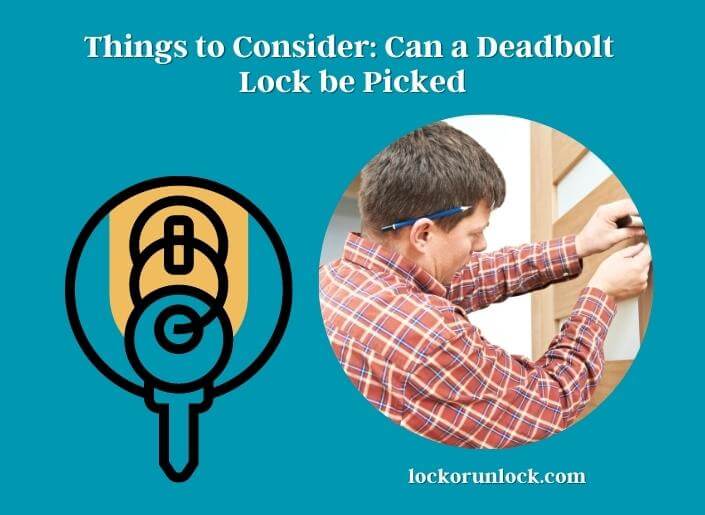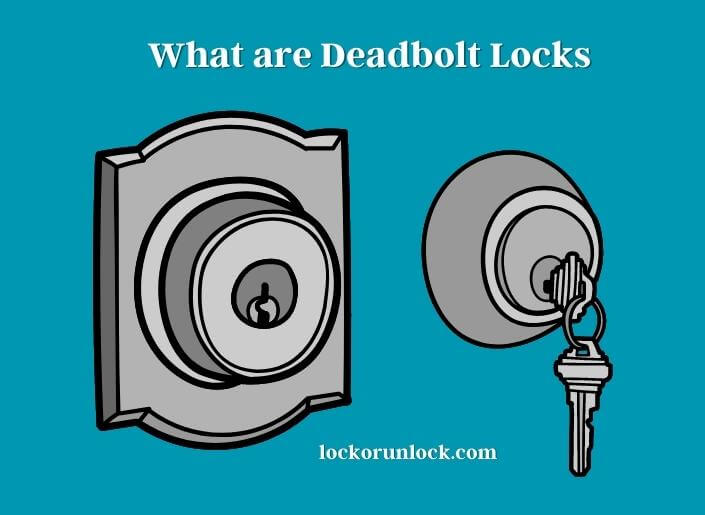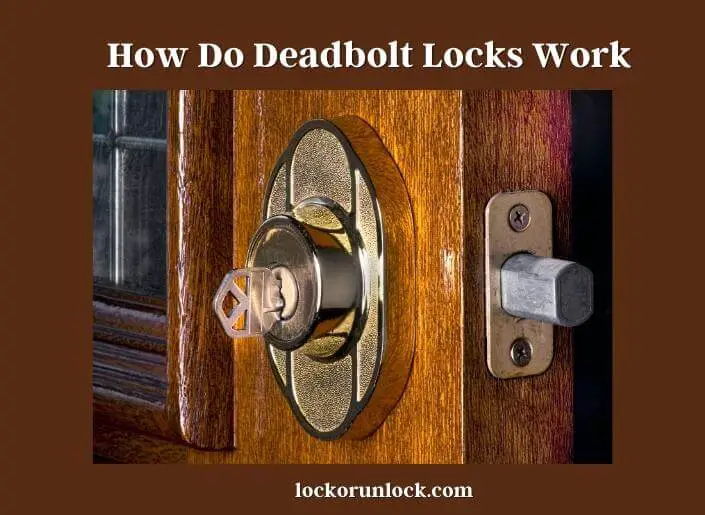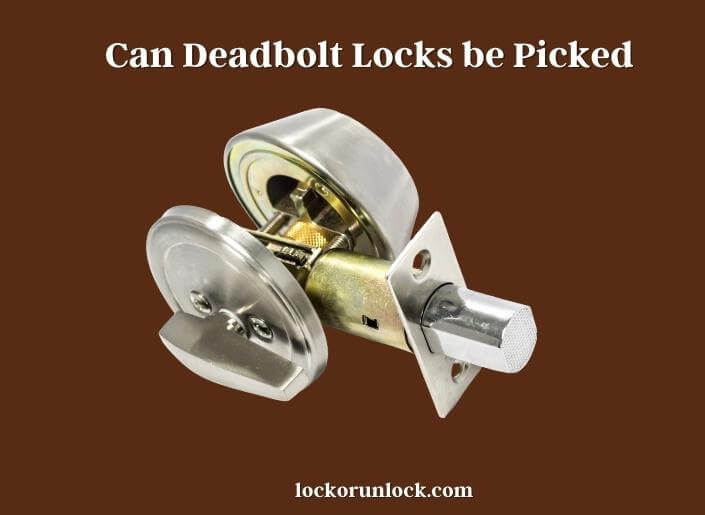The deadbolt lock is a type of locking mechanism used for centuries to secure doors and protect homes and businesses. The history of the deadbolt lock can be traced back to the ancient Roman Empire, where wooden locks were used to secure doors.

In the 18th century, British inventor Robert Barron developed the deadbolt lock as we know it today. Barron’s design featured a bolt that could be moved by a key, making it much more difficult to pick than previous lock designs. The Barron deadbolt lock was widely adopted in England and eventually made its way to the United States in the 19th century.
The deadbolt lock became increasingly popular in the United States during the 20th century, as crime rates began to rise and homeowners sought more secure ways to protect their property.
We will explore the question “can a deadbolt lock be picked?” by examining the different types of locks, the techniques used for lock picking, and the factors that make some locks more susceptible to picking than others.
We will also provide tips on increasing the security of your deadbolt lock and other measures to keep your home or business safe from intruders.
What are Deadbolt Locks?
Unlike traditional spring bolt locks, which can be easily forced open with a credit card or similar tool, deadbolt locks use a bolt that extends deep into the door frame, making it much more difficult to force the door open.

Deadbolt locks come in several varieties, including single-cylinder, double-cylinder, and smart deadbolts. Single-cylinder deadbolts are the most common type, featuring a key cylinder on the outside of the door and a thumb turn on the inside. Double-cylinder deadbolts have a key cylinder on both sides of the door, making them more secure but more difficult to use in an emergency. Smart deadbolts use technology such as Bluetooth or Wi-Fi to allow homeowners to control their locks remotely using a smartphone app.
Deadbolt locks are a popular choice for homeowners and business owners looking to increase the security of their property. They are relatively affordable and can provide a significant deterrent against intruders, especially when used in conjunction with other security measures such as security cameras and motion sensors.
How Do Deadbolt Locks Work?
Deadbolt locks use a bolt that extends deep into the door frame, making it much more difficult to force the door open from the outside. The bolt is typically made of hardened steel and controlled by a lock mechanism. When the lock is engaged, the bolt extends into the strike plate attached to the door frame, creating a robust and secure connection between the door and the frame.

Deadbolt locks come in several varieties, including single-cylinder, double-cylinder, and smart deadbolts. Single-cylinder deadbolts are the most common type and feature a key cylinder on the outside of the door and a thumb turn on the inside. Double-cylinder deadbolts have a key cylinder on both sides of the door, making them more secure but more difficult to use in an emergency. Smart deadbolts use technology such as Bluetooth or Wi-Fi to allow homeowners to control their locks remotely using a smartphone app.
The effectiveness of a deadbolt lock depends on several factors, including the quality of the lock itself, the strength of the door and frame, and the skill level of the intruder attempting to pick the lock. However, deadbolt locks are considered one of the most effective ways to secure a door and provide an extra layer of protection against intruders.
Can Deadbolt Locks be Picked?
While deadbolt locks are generally more difficult to pick than traditional spring bolt locks, they can still be picked by a skilled intruder. Here are some points to consider regarding the vulnerability of deadbolt locks to picking:

Deadbolt Locks With a Low-quality Mechanism Are Easier to Pick
The quality of the lock mechanism significantly affects the vulnerability of a deadbolt lock to picking. Lower-quality deadbolt locks often have a more straightforward locking mechanism that is easier to pick. A higher-quality deadbolt lock is typically more resistant to picking.
The Skill Level of the Intruder
The ability of an intruder to pick a deadbolt lock depends on their skill level and the tools they have at their disposal. Picking a deadbolt lock requires a certain level of expertise and experience. An unskilled intruder may only be able to pick a deadbolt lock if it has a more straightforward mechanism.
Use of Bump Keys
Bump keys are specially designed keys that can be used to pick certain types of locks, including deadbolt locks. These keys strike the key with a hammer or similar tool, causing the pins inside the lock to jump and the lock to open. While bump keys are not effective on all deadbolt locks, they can be used to open some lower-quality locks.
How Effective are Bump Keys in Picking Deadbolt Locks?
Bump key effectiveness on deadbolts is a subject of debate among locksmiths. While bump keys can theoretically unlock deadbolt locks quickly, their success rate is influenced by factors such as lock quality and skill level of the person using them. Some argue that bump keys are less effective on higher-quality locks, requiring alternative picking methods.
Use of Other Picking Tools
Skilled intruders may also use other picking tools, such as lock picks and tension wrenches, to manipulate the pins inside the lock and open it. However, this requires a high skill level and is much less common than using bump keys.
Techniques for Picking Deadbolt Locks
It’s important to note that picking a deadbolt lock without the proper training or legal authorization is illegal and should not be tried. However, for educational purposes, here are some techniques that skilled locksmiths or law enforcement may use to pick a deadbolt lock:
Single Pin Picking
This involves inserting a specialized tool, a pick, into the lock’s keyway and manipulating each pin individually until they align properly and the lock opens.
Raking
This involves inserting a tool known as a rake into the lock’s keyway and quickly moving it up and down to bounce the pins until they align and the lock opens.
Impressioning
This involves using a specially crafted key blank to make an impression of the keyway and the position of the pins. The locksmith or law enforcement officer can then use this information to create a new key that can open the lock.
Bypassing
This involves finding weaknesses in the lock’s mechanism, such as a poorly installed strike plate, and using a specialized tool to manipulate the lock without picking it directly.
Again, it is important to note that attempting to pick a deadbolt lock without proper training or legal authorization is illegal and can result in severe consequences. If you are having difficulty opening a locked door, it is recommended to contact a licensed locksmith or law enforcement officer for assistance.
Tips to Secure Your Home Against Lock Picking Attempts
Here are some tips to help secure your home against lock-picking attempts:
Install High-Security Locks
Choose locks that are designed to resist picking and other forced entry techniques. Look for locks tested and certified by independent organizations, such as UL or ANSI.
Upgrade to Smart Locks
Smart locks offer added security features, such as the ability to remotely control your lock and receive alerts when the lock is opened or tampered with. Some smart locks also have features like auto-locking and creating unique access codes for different users.
Use Longer Screws
Use longer screws to install your locks and strike plates. This will make it more difficult for intruders to open the door.
Reinforce Doors and Frames
Consider reinforcing your doors and frames with metal plates or bars. This can prevent forced entry by making it more difficult to kick in or pry open the door.
Install Security Cameras
Security cameras can deter potential intruders and provide valuable footage in the event of a break-in. Place cameras near entry points and make sure they are visible to anyone approaching the door.
Keep Your Property Well-lit
Ensure that the area around your doors and windows is always well-lit. This can help to deter intruders and make it more difficult for them to attempt to pick your locks.
Bottom Line
Deadbolt locks are generally secure and effective at preventing unauthorized entry. Experienced and determined intruders can pick them. Some steps can be taken to increase the security of your deadbolt locks, such as installing high-quality locks, using longer screws, upgrading to smart locks, reinforcing doors and frames, installing security cameras, and keeping your property well-lit.
This article will help you to ensure that your home or business is as secure as possible and deter potential intruders from attempting to pick your locks.
Read more:
